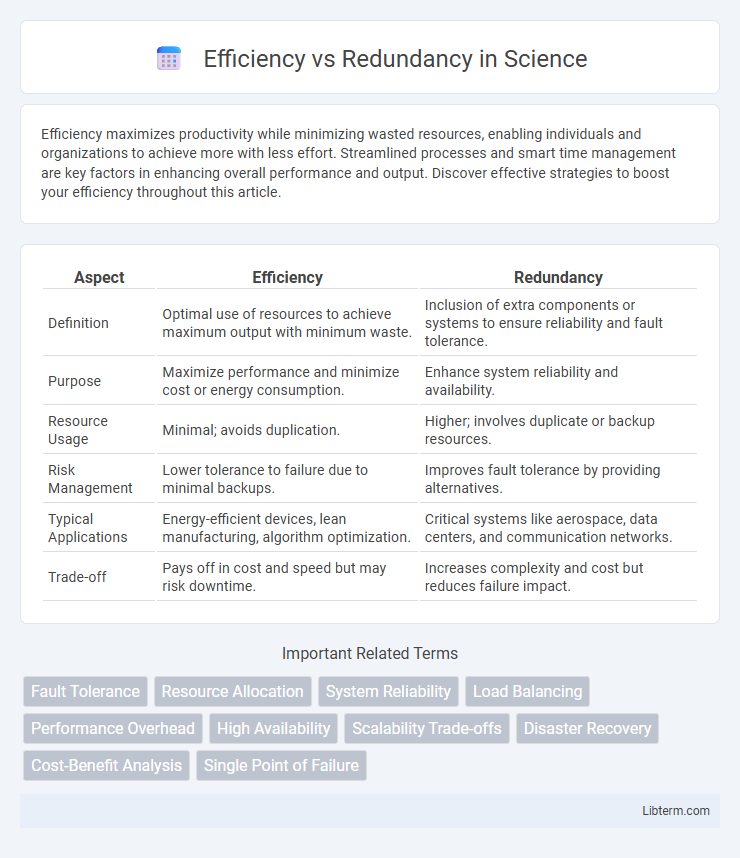Efficiency maximizes productivity while minimizing wasted resources, enabling individuals and organizations to achieve more with less effort. Streamlined processes and smart time management are key factors in enhancing overall performance and output. Discover effective strategies to boost your efficiency throughout this article.
Table of Comparison
| Aspect | Efficiency | Redundancy |
|---|---|---|
| Definition | Optimal use of resources to achieve maximum output with minimum waste. | Inclusion of extra components or systems to ensure reliability and fault tolerance. |
| Purpose | Maximize performance and minimize cost or energy consumption. | Enhance system reliability and availability. |
| Resource Usage | Minimal; avoids duplication. | Higher; involves duplicate or backup resources. |
| Risk Management | Lower tolerance to failure due to minimal backups. | Improves fault tolerance by providing alternatives. |
| Typical Applications | Energy-efficient devices, lean manufacturing, algorithm optimization. | Critical systems like aerospace, data centers, and communication networks. |
| Trade-off | Pays off in cost and speed but may risk downtime. | Increases complexity and cost but reduces failure impact. |
Introduction to Efficiency and Redundancy
Efficiency measures the optimal use of resources to achieve desired outcomes with minimal waste, often quantified by performance metrics such as throughput or energy consumption. Redundancy involves incorporating additional components or systems beyond the minimum necessary to enhance reliability, fault tolerance, and availability. Balancing efficiency and redundancy is critical in system design to ensure robust operation without excessive resource expenditure.
Defining Efficiency in Systems
Efficiency in systems measures the optimal use of resources to achieve maximum output with minimal waste, energy, and time. It involves streamlined processes, reduced redundancy, and effective allocation of inputs to enhance performance and cost-effectiveness. Emphasizing efficiency drives system improvements by minimizing unnecessary repetition and maximizing productivity across interconnected components.
Understanding Redundancy: Purpose and Types
Redundancy serves as a critical mechanism in systems to enhance reliability and fault tolerance by duplicating components or functions. Types of redundancy include hardware redundancy, such as multiple power supplies in servers; software redundancy, involving backup algorithms or code; and information redundancy, like error-correcting codes in data transmission. Understanding the purpose of redundancy helps balance efficiency and safety, ensuring continuous operation despite failures or unexpected disruptions.
Efficiency vs Redundancy: Key Differences
Efficiency prioritizes minimizing resource use while maximizing output, ensuring streamlined processes and cost-effectiveness. Redundancy involves duplicating key components or data to enhance reliability and fault tolerance, often at the expense of increased resource consumption. The key difference lies in efficiency seeking optimal performance with minimal waste, whereas redundancy accepts extra overhead to guarantee system robustness and availability.
Benefits of Prioritizing Efficiency
Prioritizing efficiency reduces resource waste by optimizing processes and minimizing unnecessary tasks, leading to cost savings and faster project completion. Efficient systems enhance productivity by streamlining workflows and improving task allocation, which increases overall output with fewer inputs. Businesses that focus on efficiency gain a competitive advantage through improved operational performance and better utilization of human and technological resources.
Advantages of Building Redundancy
Building redundancy enhances system reliability by ensuring continuous operation despite component failures, which reduces downtime and maintains service availability. It improves fault tolerance, enabling quick recovery and minimizing the impact of errors in critical infrastructure such as data centers and networks. Redundancy also supports load balancing, distributing tasks efficiently to prevent overload and optimize resource utilization.
Balancing Efficiency and Redundancy in Practice
Balancing efficiency and redundancy involves implementing systems that optimize resource use while maintaining backup mechanisms to ensure reliability and prevent failure. Efficient processes streamline operations by minimizing waste and maximizing output, whereas redundancy provides fault tolerance through duplicate components or data paths. Achieving the right balance requires analyzing risks, critical system needs, and potential downtime costs to design resilient yet cost-effective solutions.
Real-World Examples: Striking the Right Balance
Efficiency in supply chain management reduces costs and speeds up delivery, while redundancy ensures reliability by providing backup resources during disruptions. Companies like Amazon use advanced algorithms to optimize warehouse locations, balancing efficient inventory turnover with redundant stock to prevent stockouts. In aviation, airlines maintain redundant systems and backup crews to guarantee safety and continuity despite emphasizing efficient scheduling and turnaround times.
Industry-Specific Considerations
Efficiency in manufacturing prioritizes lean processes to minimize waste and reduce costs, while redundancy ensures backup systems for critical equipment, safeguarding against operational disruptions. In healthcare, redundancy in medical devices and supply chains is vital to maintain patient safety and comply with regulatory standards, whereas efficiency focuses on optimizing staff workflows and resource allocation. The energy sector balances efficiency by maximizing output from limited resources with redundancy through multiple fail-safes and backup power systems to ensure continuous service delivery.
Future Trends: Optimizing for Both Efficiency and Redundancy
Future trends in technology emphasize a balanced approach that optimizes both efficiency and redundancy to ensure robust system performance. Advances in AI-driven resource management enable dynamic allocation, minimizing waste while maintaining fail-safes for critical operations. Edge computing and decentralized architectures enhance this balance by distributing workloads to reduce latency and increase fault tolerance.
Efficiency Infographic

 libterm.com
libterm.com